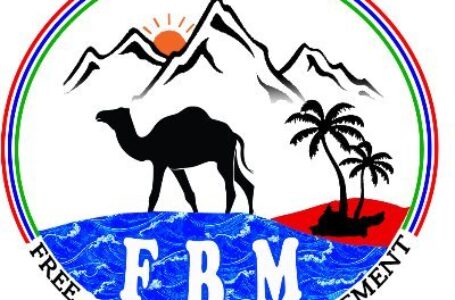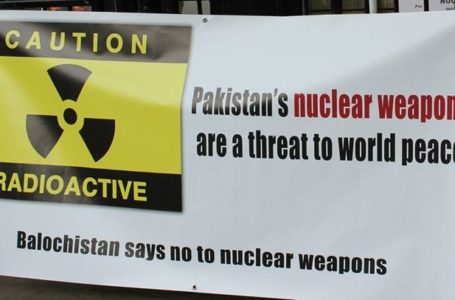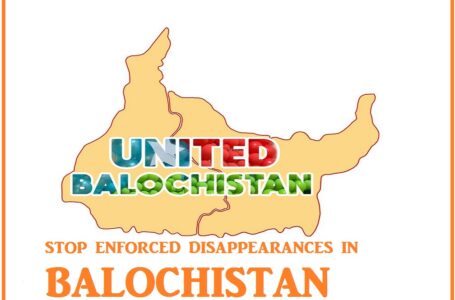Indian State Should Focus on Unconventional Methods: Jamal Nasir Baloch
Chaghai: the Hiroshima of Balochistan

By: Sobdar Baluch
A Pakistani official who cheered and raised Jihadist slogans of ‘Allah o Akbar’ during detonating the nuclear bombs on Baloch soil 18 year ago described devastating situation as following, “A short while after the button was pushed, the earth in and around the Raaskoh Hills trembled. The Observation Post (OP) vibrated as smoke and dust burst out through the five points where the nuclear devices were located. The mountain shook and changed colour as the dust of thousands of years was dislodged from its surface. Its black granite rock turning white as de-oxidization from the radioactive nuclear forces operating from within. A Huge cloud of beige dust then enveloped the mountain.”
Profile of Chaghai “Raaskoh”
Chaghai, some 270km far from Capital Quetta, famous for its top quality of grapes, pomegranates, the 40 million people of Balochistan after the annexation of their land on the barrel of the gun into Pakistan on 27 March 1948, once again witnessed another curse on their soil as their neighboring rogue state of Pakistan carried out 5 underground deadliest powerful nuclear blasts in civilian populated areas in 2 consecutive days 28-30 May 1998.
This manmade disaster is undoubtedly a national tragedy for the entire Baloch nation. Baloch people remember 28 May as one of the darkest days of their history and organize protest demonstrations every year to demand an independent enquiry into the diseases that erupted after the testing of Pakistan’s dirty nukes. Baloch also demand that Pakistan’s should be stripped off its nuclear weapons, given its friendly relation with Taliban and other extremist groups that operate freely in Pakistan.
Chaghai 1st blast: In the first test four atomic bombs were detonated on 28 May 1998 where more than 36 kiloton nuclear bombs (1 kiloton bomb = 1000 tons) were exploded. 1 megaton weapon would have the energy equivalent of 1 million tons of TNT.
Chaghai 2nd blast: On 30 May 1998 with 12 kilotons on the same area under the mountains of Raaskoh which boosted the emissions of radioactive radiations.
The left wings of the rigid mountains of Raaskoh falls on South side of the district of Chaghai some 75km far from army head quarter in Chaghai and other part of Raaskoh comes on the territory of Kharan District which is at its South.
After the tests of Pakistan’s dirty nuke, Balochistan experienced a country wide and a massive scale of drought which claimed the lives of millions of livestock. The agriculture sector of the country was badly affected, domestic economy of the people collapsed and many died due to radioactivity.
Since the nuclear tests every year abnormal babies are born and the number of cancer patients has also increased dramatically, Skin diseases have become common among all ages in the area. After 18 years now, the concerns of Baloch genuine leadership and people have proved right. The annual level of rainfalls in Balochistan particularly in Chaghai has significantly dropped.
Balochistan’s wild life the victim of Pakistan’s dirty nuke
Pakistani officials, army and media have been telling lies to the world that the nuclear tests were carried out far from the civil population but a visit to the region will prove them wrong because the blast site is surrounded by Baloch inhabitants and mountains are abode to different species of wild creatures. Hence, along with Baloch people the wild life of Balochistan have also paid a heavy price as a result of Pakistan’s dirty bomb but unfortunately the independent medical experts and the animal rights groups have turned a blind eye to the suffering of Chaghai region in Balochistan. The International media, medical experts and even the UN special teams remained silent and relied on the reports of Pakistani media and government. Chaghai continues to burn but the world at large remains silent spectators to the destruction and slow death of Raaskoh.
Data retrieved from annual report on Chaghai District by Planning and Development Department, Government of Balochistan shows that the following mountainous creatures continue to suffer after the nuclear test in Chaghai and they’re now becoming extinct.
Mammals: Desert Fox, Asiatic Jackal, Cape Hare, Porcupine, Afghan Hedgehog, etc. The area is also the habitat of the threatened Desert Deer, Goitered Gazelle, Pigmy Jerboa etc.
Birds: Houbara Bustard, See-see Partridge, a number of Sparrows, Finches, Buntings, seasonal/migratory Waterfowls, Hawks, and Sand Grouse etc.
Reptiles: Turkestan Rock Gecko, Sharp-tailed Spider Gecko, Lumsdeni Gecko, Whiptailed Sand Gecko, Baloch Spiny-tailed Lizard, Mountain Dwarf Gecko, Short-toed Sand Swimmer, Easter Dwarf Skink, Indian Desert Monitor, Reticulate Desert Lacerta, Caspian Desert Lacerta, Chaghai Desert Lacerta, Dark Headed Dwarf Racer, Tartary Sand Boa, Spotted Desert Racer, Dark Headed Gamma Snake, Maynard’s Awl-headed Snake, Afghan Tortoise, Indian Cobra, Leaf Nose Viper and Lizards like Agamura Femoralis, Stenodactylus Maynardi, etc.
Data retrieved from annual report on Chaghai District by Planning & Development Department, Government of Balochsitan with collaboration of UNICEF. Published on June 2011.
Baloch concerns unnoticed
The pro-freedom Baloch leader Hyrbyair Marri not only protested against the Nuclear Tests in Balochistan in 1998 but he also cautioned about long term effects of these tests on Baloch people and Balochistan. Mr Marri is one of the most senior and dedicated leaders of the current Baloch freedom struggle. He knew the evil designs of Pakistan that’s why he issued a statement against nuclear blasts eight days before the blast were carried out.
His statement read: “There is no scarcity of such barren lands in other parts of Pakistan, such as Cholistan and Tharparker Badin all these areas are appropriate places for the tests. These places are also adjacent to Rajasthan state where India has conducted its all nuclear test series”.
Another concern of Mr Marri at the time was that these blasts will have far reaching effects on people of Balochistan and of the region for generations to come. Hyrbyair Marri’s statement has become part of the history and his concerns are proving right today.
The Pakistani media to this day is busy praising and boasting about the nuclear tests and Pakistan becoming the first ‘Islamic nation to possess nuclear arms’ but they ignore the effects of these nuclear arms on people of Balochistan. The Pakistani state media has never talked about the dangers that the people of region will are facing because of Pakistan’s nuclear weapons. The world media and Human Rights groups also toed the same line because none of the independent international media groups has ever tried to visit Chaghai and witness the ongoing destruction these blasts have caused.
The analysts believe that increasing ties between China and Pakistan is actually based on military intelligence sharing, geo strategic cooperation. Pakistan officially announced having 120 atomic bombs but it is presumed that she has more than 200 atomic bombs at present, the rest are hidden. These weapons are not only a threat to the existence of Baloch nation but they are also a danger for the wider world.
An irresponsible state like Pakistan whose army has been training, arming and nurturing religious extremists and Jihadist terrorist for centuries, is not capable of securing its nuclear weapons. Pakistan is a money hungry corrupt state; the chances are high that it will sell its nuclear weapons not only to other extremist countries but also to the Jihadist terrorist who are hell-bent on destroying the world peace. One should only wonder for a second that these Jihadist terrorist with light weapons have created a havoc around the world – what they can do if they get their hands on the trigger of a nuclear bomb!
Taliban visits Pakistani nuke sites in Balochistan
The local people of Dalbandin and Noshki say that they have noticed unusual military movements in and around Dalbandin at the Headquarters of Pakistani army where Pakistani nuclear deposits are located. They say there are people within Pakistan army who brought leaders of religious groups to their military bases. The killing of Mullah Akhtar Mansour in a US drone attack in that region is a clear example of Pakistan’s army’s collaboration with the Taliban and other Jihadist extremist groups. I have mentioned in my previous writings that Taliban leadership enjoys full backing and support of Pakistani army and death of yet another high profile Taliban leader is proof that the collaboration continues. The Foreign affairs adviser of Pakistan Mr Sartaj Aziz has admitted on several occasions that Taliban leader and their families live in Pakistan and governments is aware of this. The important question that need to answer is that what was Mullah Mansour actually doing in Dalbandin and Noshki areas of occupied Balochistan? One of the possible answers could be he was either trying to get his hands of nuclear weapons or he had met with his other fellow Jihadist terrorist to carry out more attacks in Afghanistan.
It is worth mentioning that a considerable number of Pakistani nuclear weapon deposits are situated in Dalbandin, Chaghai and Kharan districts of occupied Balochistan. Pakistan army’s headquarters in Chaghai and Dalbandin are supervising the nuclear activities deep under the bunkers on the hilly areas of Chaghai and Dalbandin. Experts believe that probably the killed Taliban leader Mullah Mansour was not alone in Dalbandin but he was on an organizational visit to the area to get briefing on the know-how of Nukes. There is no doubt that Pakistani ISI is training the Taliban, the Haqani Network fighters and other Jihadists to counter the US, Afghanistan and India joint efforts to curb global terrorism.
Experts are also of the view that Pakistan army is trying to bring a major chunk of Taliban and other Jihadist groups on Baloch-Afghan bordering areas to protect Chines army engineers who are updating and assembling the Pakistani nuclear devices for tactical use. Pakistan has always regarded the Taliban as its national assets and the recent visit of deceased leader of Taliban to the nuclear deposits in Dalbandin is alarming for the world community and it must be tackled immediately without any delay.
The short term solution to prevent Pakistan to use tactical weapons is the immediate dismantling of its nuclear weapons.
A more viable and long terms solution to contain Pakistani hooliganism around the world is that the world’s peaceful and democratic nations should support the Baloch struggle for national liberation because an Independent Baloch state can play an enormous role in bringing peace in world and become an obstacle in the way of influx of Pakistan’s sponsored terrorists to Afghanistan and India. Baloch are also very clear about the nuclear arm race and Pakistan’s nuclear activities in Balochistan.
The Article 73 of the Balochistan Liberation Charter clearly reads that Balochistan will be a nuclear free state, “Soon after regaining independence immediate action will be taken for the complete removal and eradication of all nuclear activities in Balochistan. Nuclear tests were conducted, against the wishes and without the consent of Baloch people, in Balochistan. They were carried out by Pakistan in the Raaskoh range and Chaagi district of Balochistan on 28th May 1998.
An independent investigation, by the United Nations, on the impact of these tests on the people and environment in these regions in Balochistan will be requested. The areas that have been contaminated by radio toxicity will be cleaned and there will be independent scientific research carried out to establish the damage caused on the environment and the effects of radiation on the people living in these regions. The State responsible for this crime against the Baloch people will be held accountable and justice will be sought through the international system of justice. Any state held to account should also be made to pay compensation to those people affected from the disaster.”












